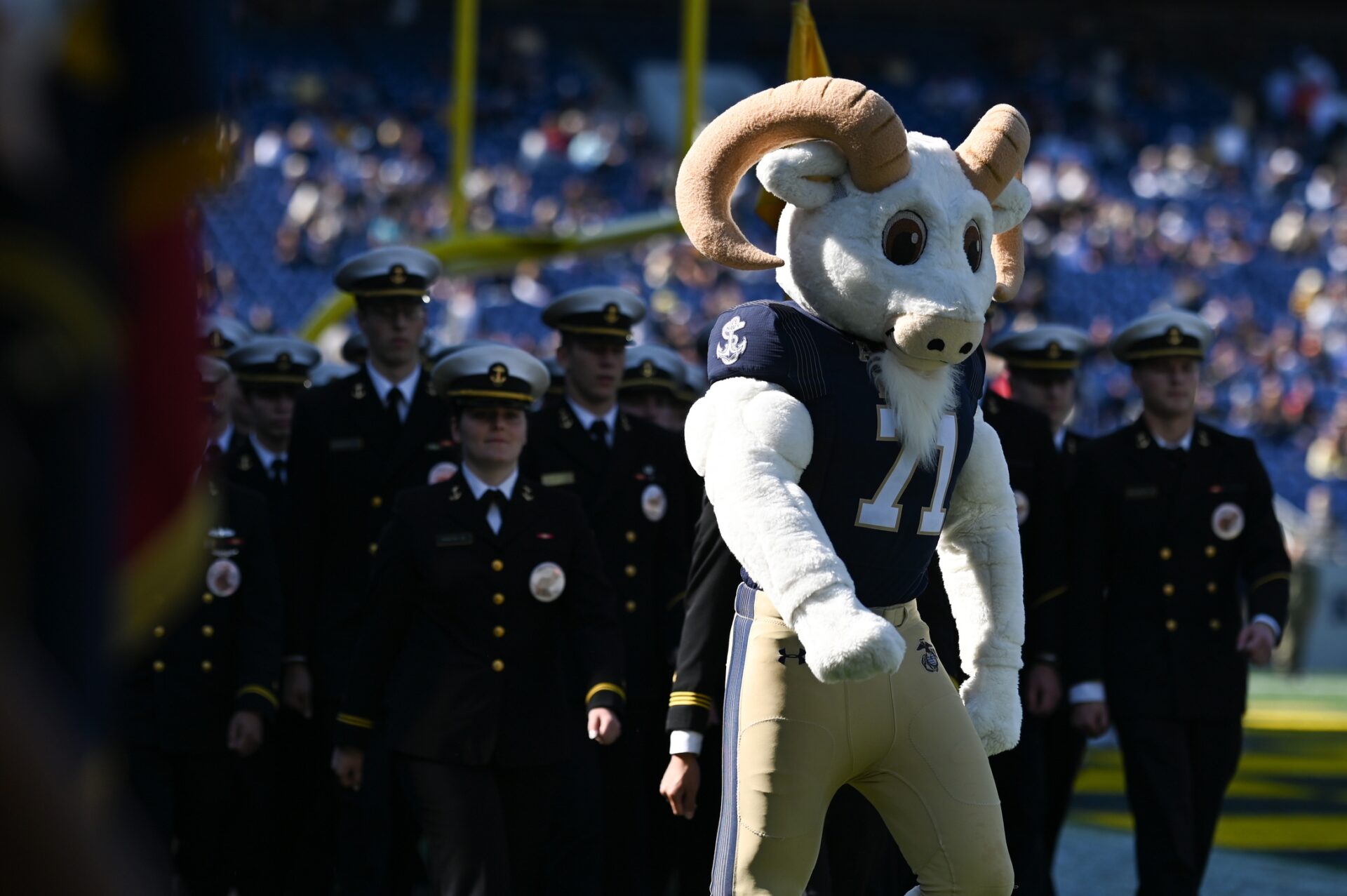An anchor. A naval warship. A fighter jet. These are the things that, if you didn’t know better, might epitomize your thoughts when asked what the Navy Midshipmen mascot might be. Yet, the reality is far from anything so obviously associated with the United States Navy football program.

What Is the Navy Midshipmen Mascot?
Bill the Goat is the Midshipmen mascot. The unexpected mascot of Navy’s football program is one of the most long-tenured mascots in college football history. The Midshipmen have been represented by a goat since the late 1800s, with the first official live goat mascot appearing in 1893.
MORE: AAC QB Rankings 2023
Since then, there have been many versions of Bill the Goat, and the Midshipmen mascot has kept his name since the early 1900s. Meanwhile, the live animal mascot has been joined by a costumed mascot who always sports the No. 71 — in reference to the Class of 1971 and not because he plays on the offensive line.
Why Is the Midshipmen Mascot Named Bill?
The Midshipmen mascot was named Bill the Goat in the early 1900s. The live goat, which was dressed in a blanket embroidered with the “NAVY” in the unmistakable gold of the program, was taken from the USS New York and patrolled the sidelines of the rivalry game with Army.
The goat appeared to bring good luck, resulting in an 11-7 win for Navy over their bitter rivals. During a train ride back, the midshipmen decided to name their new mascot “Bill” in honor of another goat owned by Commander Colby M. Chester, who was the first president of the Naval Academy Athletic Association.
There have been many goats who have taken on the great “Bill the Goat” moniker as the Midshipmen mascot. The most recent is Bill 37, replacing the previous goat who passed away in April 2022.
Several of the goats that have been the Midshipmen mascot have been involved in abduction attempts by rival schools. In 1953, President Dwight D. Eisenhower ordered the return of Bill the Goat to Annapolis after he was kidnapped by a group of Army cadets. Maryland students joined the fray in 1964, while Air Force cadets have been involved in multiple kidnap attempts on the Midshipmen mascot.
However, a retaliatory attempt by a large group of midshipmen that included the cutting of phone lines and taking hostage of six Army employees, and the kidnapping of four West Point mules, saw an official end to mascot stealing between the service academies, with the successful 1990 abduction of Bill the Goat being the final act in the abduction saga.
Why Is the Navy Mascot a Goat?
So, we know that the Midshipmen mascot is Bill the Goat, we know why he’s called Bill, and we’ve also found out about the many abduction attempts on the poor four-legged friend of the Navy football program. But, why is the Navy mascot a goat?!
According to the United State Naval Academy Public Affairs Office, goats have been a long companion of midshipmen when out at sea. They were routinely kept on board vessels as a low-maintenance way to provide food such as milk and eggs. Meanwhile, they’ve been known to provide company as pets too.
Allegedly, the Midshipmen mascot hails from this unlikely partnership. The story goes that in the 1800s, the midshipmen formed such a strong alliance with their onboard goat that when it died while out at sea, they couldn’t bear to part with it.
MORE: 2023 AAC Weekly Football Schedule
So, instead, they shaved the skin with the intention of having it mounted when back on dry land. However, on the way to enshrining the skin forever, the two midshipmen took it to a Navy game, where one of them proceeded to wear it as he ran up and down the sideline.
In addition to providing entertainment for the crowd, the presence of the goat was considered good luck since Navy won the game. While the bond between Navy and animal was officially formed that day, it wasn’t until 1893 that a live goat mascot was used by the football program.
That first live goat Midshipmen mascot wasn’t named Bill the Goat — the name didn’t come in until the early 1900s. Instead, he was named El Cid (The Chief), and he presided over a Navy victory over Army.

